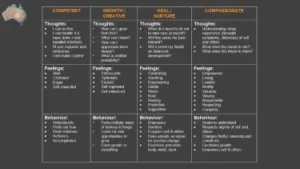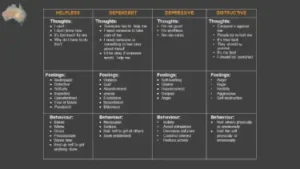Description
Empowering Australian voters. Learn how Australian voters can transition from passive observers to active participants in democracy, shaping the nation’s future.
Introduction: The Power of the Australian Voters

In today’s rapidly changing political landscape, Australian voters face a critical decision: remain passive or become active participants in shaping their nation’s future. The difference between a passive and active voter can decide the direction of policies, influence political accountability, and safeguard democracy.
This article will explore how Australian voters can transition from a “weak mode of self,” characterized by passivity, to a “power mode of self,” marked by active engagement and influence in the political process. Follow this link for more about “Empowering Australian Voters”
I. Understanding the Weak Mode of Self in Australian Voters
A. Definition and Characteristics

The weak mode of self is a psychological state where individuals feel disempowered, passive, and disengaged. In the political context, this mode manifests when voters feel that their individual vote or voice has negligible impact on the broader political system. They may adopt a “why bother” attitude, leading to low voter turnout, political apathy, and a general disengagement from civic duties.
Passive Voters
Passive voters tend to disengage from the political process, missing opportunities to influence decisions that directly impact their lives.
B. Political Manifestation
In Australia, the weak mode of self is reflected in voter behaviour, particularly during elections where a huge part of the electorate is still indifferent or votes without fully understanding the implications of their choices. This passivity allows political elites to push agendas that may not align with the public interest, knowing that the electorate is less likely to hold them accountable.
C. Examples in Australian History
Australia has seen periods of low voter engagement, where crucial decisions were made with little public scrutiny. For instance, the neoliberal shift in the 1980s and 1990s, which led to the privatization of public assets, occurred with minimal resistance from a passive electorate. This period serves as a reminder of the dangers of a weak mode of self in political engagement.
II. Consequences of Weak Mode Engagement
A. Policy Outcomes Favouring Elites

When voters operate in a weak mode, policies often cater to the interests of a select few rather than the broader public. For example, the continued support for fossil fuel industries, despite the growing demand for sustainable energy, can be attributed to the influence of powerful lobbies that thrive in a political environment where voter engagement is low.
B. Threats to Australian Democracy
A disengaged electorate poses a significant threat to democracy. Without active voter participation, the checks and balances that prevent corruption and abuse of power weaken. This erosion of democratic principles can lead to a government that works with little regard for transparency or accountability.
C. Perpetuation of Social Inequities
The weak mode of self among voters often leads to the perpetuation of social and economic inequities. For example, policies that do not address the housing crisis or the increasing cost of living disproportionately affect the most vulnerable in society. When voters do not actively demand change, these issues stay unaddressed.
III. Transitioning to a Power Mode of Self
A. Characteristics of the Power Mode
In contrast to the weak mode, the power mode of self is defined by active participation, critical thinking, and a powerful sense of agency. Voters in this mode are informed, engaged, and proactive in shaping political discourse. They understand the value of their vote and use it strategically to influence policy and hold politicians accountable.
B. Political Empowerment Strategies
1. Education and Awareness: Voters must educate themselves on the issues that matter most, from economic policies to environmental protection. This knowledge empowers them to make informed decisions at the ballot box.
2. Community Involvement: Engaging with local community groups and attending town hall meetings are effective ways for voters to voice their concerns and influence local governance.
3. Political Advocacy: Joining or supporting advocacy groups that align with one’s values can amplify a voter’s impact. These groups often have the resources to lobby politicians and push for policy changes.
C. Practical Steps for Australian Voters
1. Research Candidates and Policies: Before elections, voters should thoroughly research the candidates and their policies. Understanding the long-term implications of these policies can lead to more strategic voting.
2. Engage in Political Discussions: Whether online or in-person, discussing political issues with peers can lead to a deeper understanding of different perspectives and strengthen one’s own arguments.
3. Take part in Protests and Campaigns: Peaceful protests and grassroots campaigns are powerful tools for expressing dissatisfaction with current policies and demanding change.
IV. Case Studies: Empowerment in Action
A. Positive Examples of Voter Empowerment
In recent years, there have been instances where Australian voters successfully adopted a power mode of self, resulting in significant political changes. For example, the grassroots movement against the Adani coal mine, driven by community activism and widespread public opposition, forced political leaders to reconsider their stance on environmental issues.
B. Lessons from Successful Movements
These movements show the power of collective action and the importance of staying informed and engaged. They also highlight the potential for voters to influence policy when they work from a position of strength and agency.
V. The Role of Technology and Media
A. The Double-Edged Sword of Social Media
Social media has revolutionized political engagement, providing platforms for voters to express their views and organize around issues. However, it also poses risks, such as the spread of misinformation and the echo chamber effect, where voters are only exposed to views that reinforce their beliefs.
B. Combating Misinformation
To support a power mode of self, voters must critically evaluate the information they consume. Fact-checking sources and seeking out diverse perspectives are essential practices in today’s media landscape.
C. Using Digital Tools for Political Engagement
Digital tools, such as online petitions, crowdfunding for campaigns, and social media advocacy, can amplify the voice of the electorate. By using these tools effectively, voters can influence political discourse and drive change.
VI. The Future of Australian Democracy
A. Vision for Empowered Voters
An empowered electorate has the potential to transform Australian democracy. When voters are engaged, informed, and proactive, policies are more likely to reflect the public interest. This shift could lead to a fairer society where the government is held accountable for its actions.
B. The Long-Term Benefits of Active Engagement
Active political engagement fosters a sense of community and shared responsibility. It encourages transparency and ensures that elected officials serve the people’s interests, rather than those of powerful lobbies.
C. Call to Action
Australian voters have the power to shape the future of their country. By transitioning from a weak to a power mode of self, they can ensure that their voices are heard, and their interests are represented. It’s time to act and become an active participant in democracy.
VII. Conclusion
A. Recap of Key Points
Shifting from a weak to a power mode of self is essential for Australian voters who want to influence the direction of their country. This transition requires education, engagement, and a willingness to act.
B. Final Thoughts
The future of Australian democracy depends on an empowered electorate. By adopting a power mode of self, voters can ensure that their voices are not only heard but that they drive meaningful change.
C. Question for Readers
Are you ready to take control of your political future and become an active participant in shaping Australia’s democracy?
VIII. Call to Action
1. Subscribe to Our Newsletter: Stay informed about the latest political developments and learn how you can get involved in shaping Australia’s future.
2. Share Your Thoughts: What issues matter most to you in the upcoming elections? Join the discussion in the comments below.
3. Get Involved: Find a local political advocacy group and start making a difference today.
IX. Social Sharing
Readers are encouraged to share this article on social media using the following hashtags: #EmpoweredVoters, #AustralianDemocracy, #PoliticalEngagement, #PowerMode

